Top 10 AI Marketing Apps & Benefits – Power of Artificial Intelligence
2 years agoWhat is Featured Snippet in SEO? 10 Steps to Feature on Google Rank #1
2 years ago -

Did you know? Being at the top of search results isn’t enough. Google focuses on featured snippets in SEO and rich results by structuring your content for direct answers. In the fiercely competitive Digital landscape, securing the top spot on Google’s search results is a coveted achievement. However, with the growing competition and evolving search algorithms, simply having an online presence is not enough. To stand out, businesses and service providers must adopt strategic tactics, and one crucial aspect is optimizing for Featured Google snippets.
What is a Featured Snippets in SEO?
Featured snippets in SEO are short, highlighted answers displayed at the top of Google’s search results. Positioned above organic results and below ads, they aim to swiftly address user queries. You might observe Google snippets on certain search queries that commence with words such as “who,” “where,” “what,” “why,” “when,” “how,” and similar terms. These snippets often include a brief excerpt from a webpage and are triggered by specific search queries. Securing a featured snippet enhances a website’s visibility, credibility, and click-through rates, making it a coveted aspect of search engine optimization strategies.
Why Featured Snippets Matter for SEO Rankings?
Featured snippets are specific search results displayed at the top of Google’s organic results, providing concise answers to users’ queries. Often referred to as “position zero,” these snippets offer valuable visibility on the first page. The primary purpose of featured snippets is to promptly address users’ questions, enhancing the search experience.
The significance lies in the fact that being in position zero can substantially boost click-through rates (CTR). Studies indicate that pages with featured snippets experience a significant increase in CTR, with some reporting up to a 67% organic traffic rise. In essence, optimizing for featured snippets not only improves visibility but also drives substantial traffic to your website.
How many types of Featured Snippets in SEO?
Google presents featured snippets in SEO in various formats tailored to different query types. There are four different types of featured snippets that appear in Google’s search results.
| SN | FEATURED SNIPPETS | DESCRIPTION |
| 1. | Paragraphs | Concise answers are delivered in a paragraph format, providing a quick overview. |
| 2. | Lists | Structured information in list form, offering clarity and organization. |
| 3. | Tables | Data is presented in a tabular format, ideal for conveying organized information. |
| 4. | YouTube | Video content, often from YouTube, is sometimes featured, emphasizing the need to optimize multimedia content. |
Optimizing for paragraph-style snippets, complemented by compelling images, can enhance the effectiveness of the response.
Before exploring Google snippets in SEO further, let’s identify search queries that typically do not prompt the display of featured snippets. Google tends to showcase different features for:
- Local Queries: When you input a local query, Google commonly displays information sourced from Google Maps.
- Simple Facts: Given that straightforward facts fall within the public domain, Google usually offers a “rich answer.”
- Image Queries: For searches primarily focused on images, Google typically presents content extracted from Google Images.
- Shopping Searches: Since Google Shopping provides details about products, featured snippets are generally not credited to Shopping Searches.
1. Paragraphs Featured Snippets in SEO
Concise answers are delivered in a paragraph format, providing a quick overview.
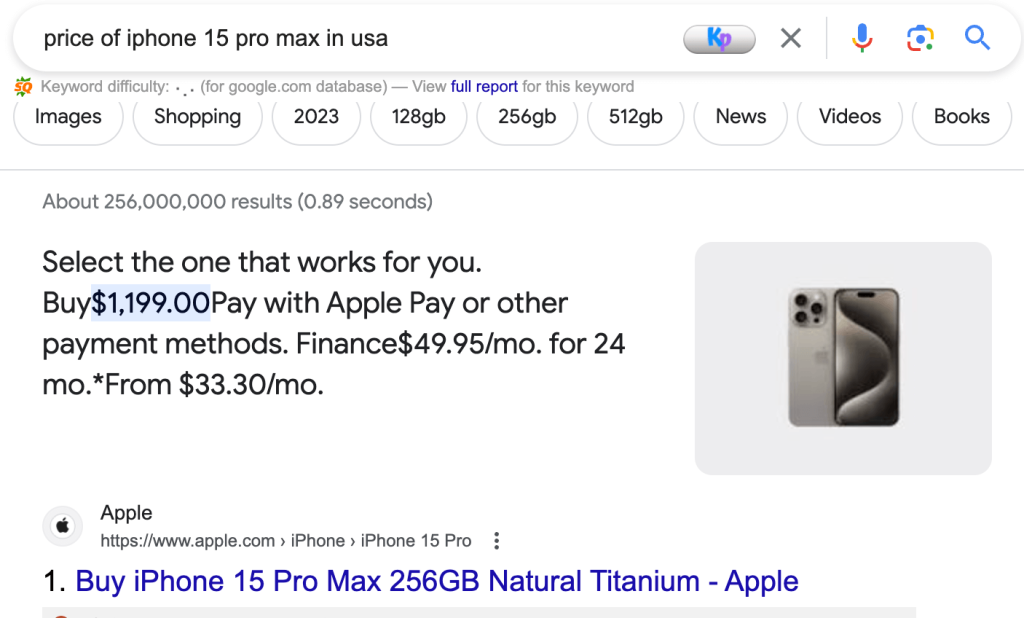
2. Lists Featured Snippets in SEO
Structured information in list form, offering clarity and organization.
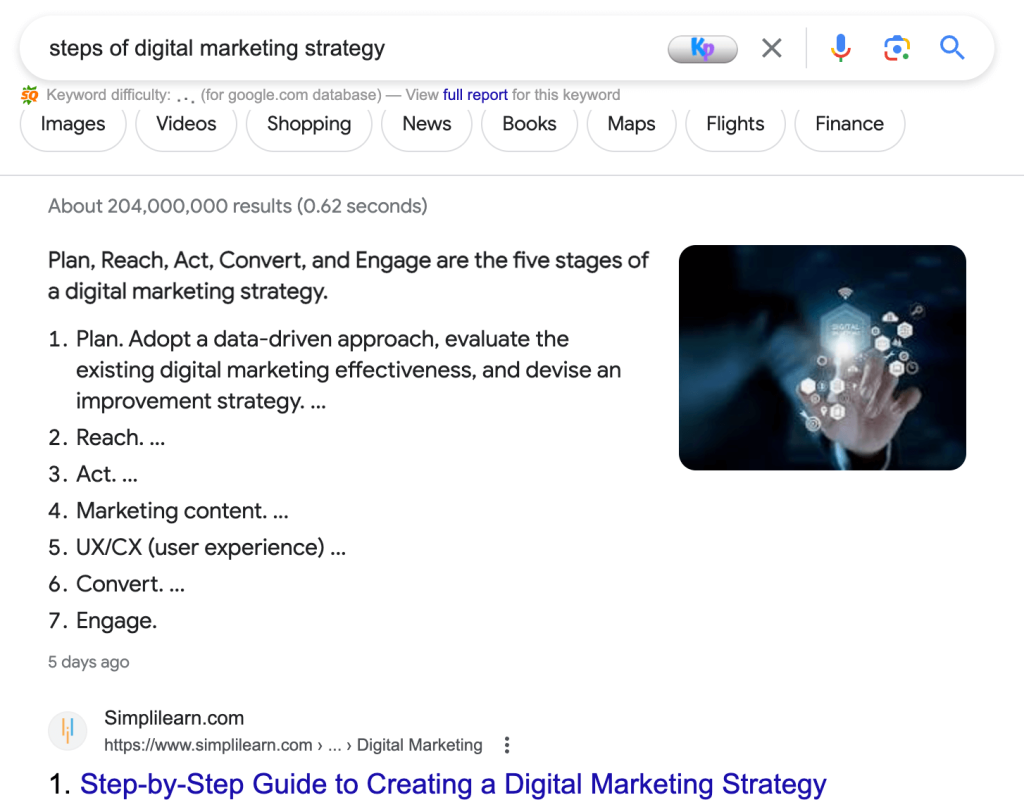
3. Tables Featured Snippets in SEO
Data is presented in a tabular format, ideal for conveying organized information.
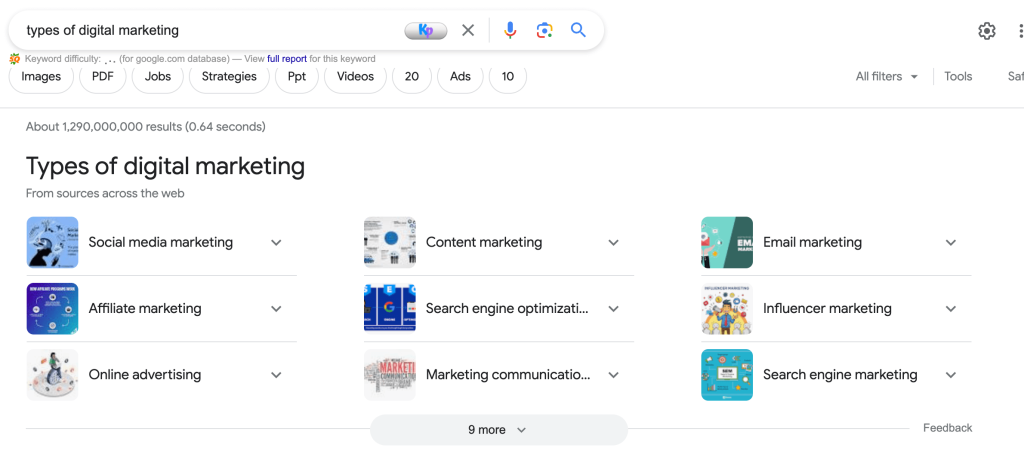
4. YouTube Featured Snippets in SEO
Video content, often from YouTube, is sometimes featured, emphasizing the need to optimize multimedia content.
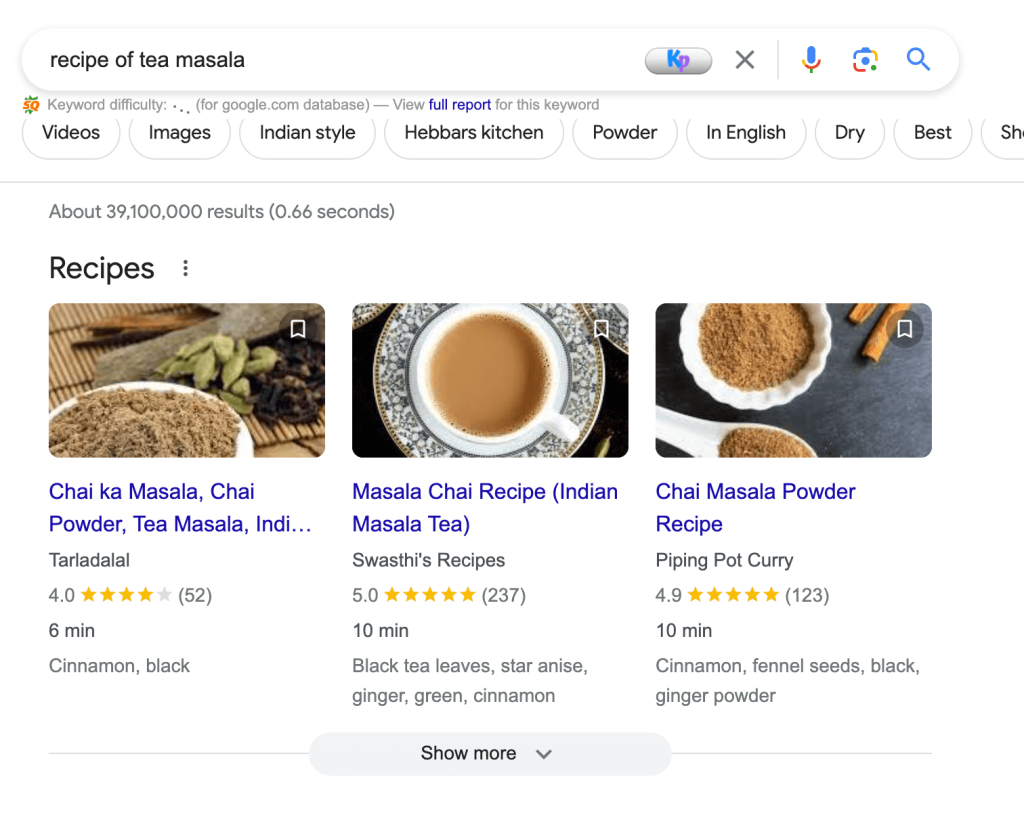
Decoding the Average CTR of Featured Snippets
Ahrefs’ examination of US search queries reveals that approximately 12.29% of searches showcase featured snippets. Intriguingly, these snippets often divert clicks from the top-ranking result, underscoring their influence on user engagement.
Understanding the average CTR of featured snippets in SEO is crucial for comprehending their impact on organic traffic. Reports suggest a significant CTR increase, ranging from 2% to 9%, accompanied by a 30% boost in overall traffic for pages with featured snippets.
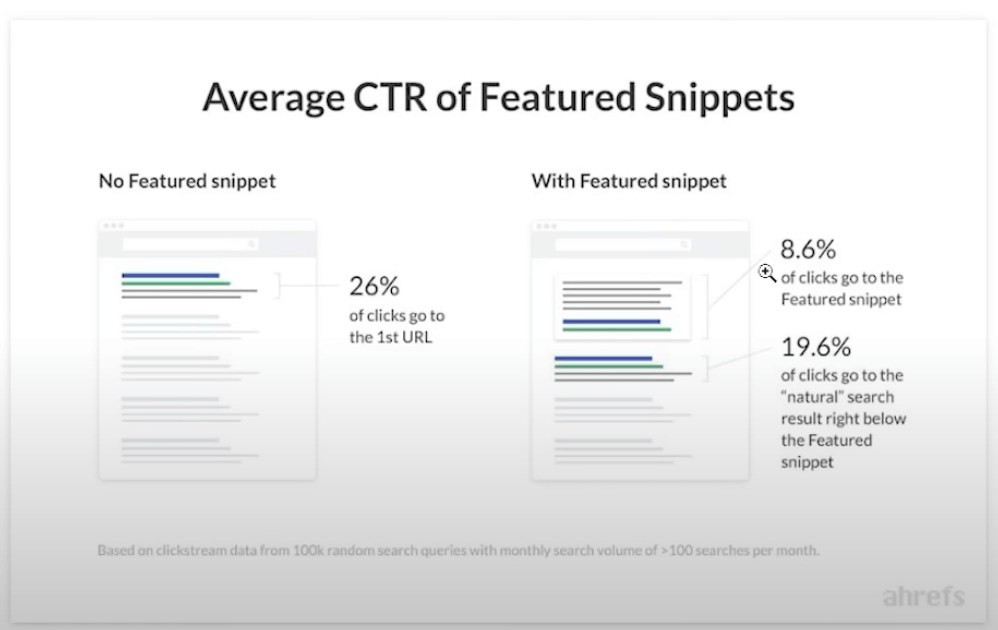
10 Useful Steps to Optimize Google Featured Snippet Position
Whether you’re a seasoned SEO professional or just stepping into the realm of online visibility, these steps offer a comprehensive strategy for navigating the intricacies of featured snippet optimization. Share the knowledge, empower your audience, and elevate your online presence!

1. Prioritize On-Page SEO
On-page SEO optimization forms the bedrock of featured snippet success. Crafting content that effectively answers user queries is crucial for securing a featured spot.
Focusing on On-Page SEO is paramount for optimizing your web content effectively. This involves tailoring various elements on your webpage to enhance its search engine visibility and user experience. Key aspects include crafting compelling and relevant content, utilizing strategic keyword placement, optimizing meta tags, and ensuring proper header structure.
Prioritizing On-Page SEO not only aligns your content with search engine algorithms but also enhances user engagement, ultimately contributing to improved search rankings.
2. Conduct Comprehensive Keyword Research
Initiate the optimization process with thorough keyword research, leveraging Free SEO tools like Ahrefs or Serpstat. Identifying search queries triggering featured results is essential for tailoring your content.
Conducting comprehensive keyword research is a fundamental step in refining your online content strategy. This process involves identifying and analyzing relevant keywords that resonate with your target audience and align with your content goals.
By understanding the search landscape, you can strategically incorporate these keywords into your content, optimizing it for search engines and increasing its visibility to your intended audience.
Allow me to outline the procedure using the Ahrefs tool. Follow these steps:
- Navigate to Site Explorer
- Enter the desired domain
- Explore Organic Keywords
- Check SERP Features
- Examine Featured Snippets
- Solely focus on linking to the target
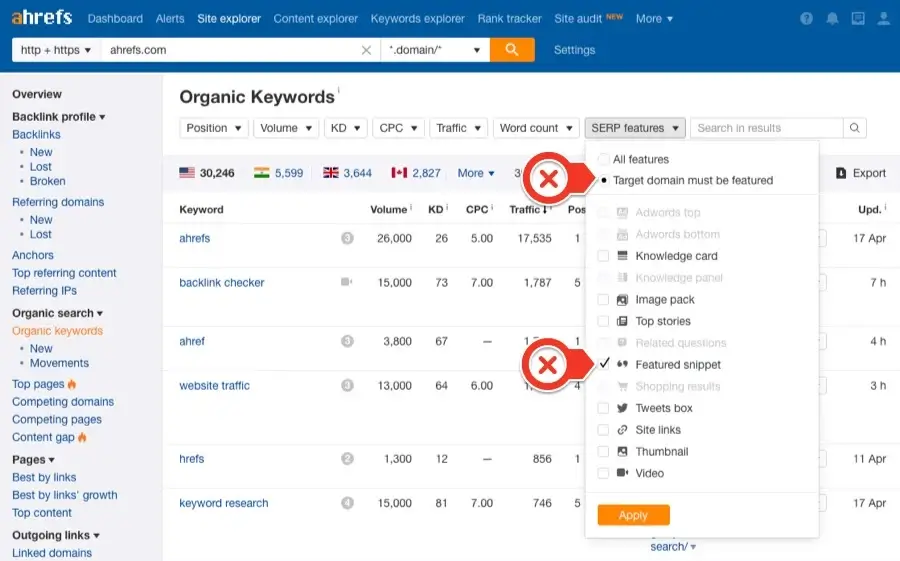
3. Analyze Competitors’ Snippets
Competitor analysis is a valuable exercise. Identify featured snippets your competitors rank for and glean insights to enhance your content.
Analyzing competitors’ snippets is a strategic approach to gaining insights into what is working in your industry’s online landscape. By scrutinizing the featured snippets your competitors currently hold, you can discern effective content strategies and identify opportunities for improvement. This process involves understanding the types of queries they are addressing, the format of their content, and the keywords targeted.
Armed with this information, you can refine your own content to compete more effectively, aiming to secure valuable featured snippet positions in search engine results.
4. Recognize High-Performing Phrases
Utilize traditional methods, such as customer feedback or tools like Seed Keywords, to identify phrases you already rank highly for.
Recognizing high-performing phrases is a crucial aspect of refining your content strategy. This involves identifying specific keywords or phrases that consistently yield positive results for your website. You can achieve this by analyzing metrics such as click-through rates, user engagement, and conversion rates associated with particular phrases.
Additionally, Free Keyword tools like the Google Search Console provide valuable insights into the search queries that bring traffic to your site. By acknowledging and leveraging these high-performing phrases, you can tailor your content to better align with user intent and improve overall performance in search engine results.
5. Address Similar Questions
A featured page is likely to attract similar queries. Structure your content to address related questions effectively.
Addressing similar questions in your content is a strategic approach to enhance the comprehensiveness of your material. Once a page earns a featured snippet, it’s likely to be associated with various related queries. By proactively addressing these similar questions within your content, you create a more informative and valuable resource for your audience.
This not only improves user experience but also increases the likelihood of securing featured snippets for a broader range of search queries, boosting your overall visibility and authority in your niche.
6. Utilize Various Phrasings
Craft comprehensive articles addressing various phrasings of the same question. Long-form content is favored by Google, enhancing your chances of being featured.
Utilizing various phrasings is a key strategy to broaden the reach and effectiveness of your content. By crafting in-depth articles that address the same question in different ways, you increase the chances of capturing a diverse audience.
Google tends to favor long-form content that comprehensively addresses user queries. Including different phrasings in your subheadings and providing immediate, clear answers enhances user experience and aligns with Google’s preference for content richness. This approach not only caters to a wider range of search queries but also improves the likelihood of securing featured snippets in search engine results.
7. Incorporate “How-To” Sections
Optimize your site for “how-to” queries, providing precise answers that align with user intent. Incorporating “How-To” sections into your website is a strategic move to meet the needs of users who often initiate searches with the “how-to” phrase.
By proactively redesigning your site to include these sections, you provide precise answers to specific search queries. Users seeking instructional guidance appreciate content that addresses their questions directly. Optimizing your content with “how-to” phrases signals to search engines that your website is a valuable resource for solving problems and answering user inquiries, potentially increasing your chances of securing featured snippets and improving overall search visibility.
8. Explore “People Also Ask” Sections
Tap into Google’s “People Also Ask” sections to uncover additional questions related to your topic. Exploring “People Also Ask” (PAA) sections is a valuable strategy for gaining insights into additional questions related to your topic.
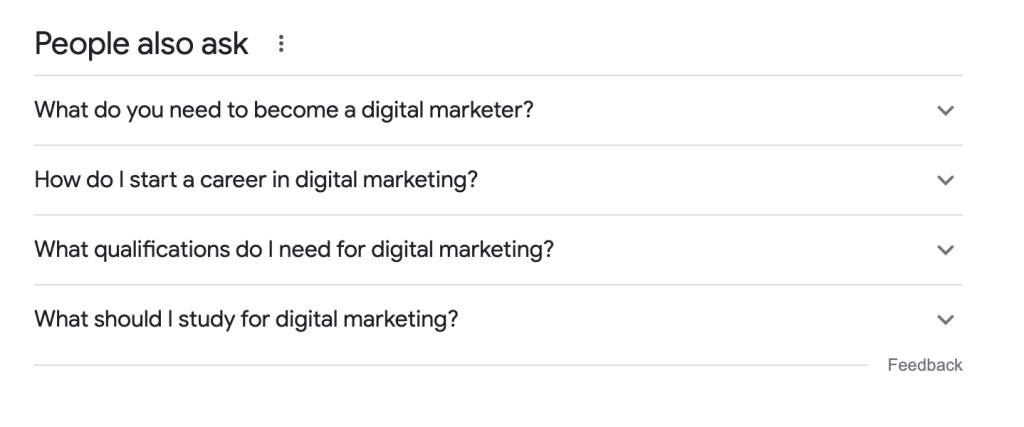
These sections, featured in Google search results, showcase queries that users commonly pose in conjunction with their original search. By delving into PAA sections, you can expand your understanding of user inquiries and tailor your content to address a broader spectrum of related questions. This not only enhances the depth of your content but also increases the likelihood of securing featured snippets and improving your website’s visibility in search engine results.
9. Organize Content Structure Strategically
Present well-structured content using paragraphs, lists, and tables. Google rewards content that is easy to navigate. Strategically organizing your content structure is essential for effective online visibility. Google values well-structured content that includes clear paragraphs, organized lists, and relevant tables.
By presenting information in a user-friendly format, you improve the overall user experience and make it easier for visitors to find what they need. Utilizing descriptive names and numbers in your lists, along with incorporating comparison charts and tables, enhances the comprehensibility of your content. This strategic approach not only aligns with Google’s preferences but also increases the chances of earning featured snippets, contributing to improved search rankings and user engagement.
10. Enhance Content with Visuals
Enrich your content with high-quality images and videos to cater to different learning styles. Enhancing content with visuals is a powerful strategy to enrich the user experience and improve the overall effectiveness of your material. High-quality images and videos not only make your content more engaging but also cater to different learning styles, appealing to a broader audience.
Studies show that featured snippets often include images, making visually enhanced content more likely to be featured prominently. Utilizing tools like Canva for creating visually appealing images and incorporating high-quality videos can positively impact user engagement, potentially leading to increased visibility in search results and a higher likelihood of securing featured snippets.
FAQs of Featured Snippets in SEO
How Does Google Choose Featured Snippets?
Google selects featured snippets based on content relevance, quality, and how well it addresses user queries. Factors include proper formatting, use of headings, and overall page authority.
Do Featured Snippets Improve Click-Through Rates?
Yes, featured snippets can significantly enhance click-through rates (CTRs). Studies indicate that being in the featured snippet position, also known as “position zero,” can lead to increased visibility and user engagement.
Can Any Website Secure a Featured Snippet?
While any website theoretically has the potential to secure a featured snippet, it often depends on factors like content quality, relevance, and existing search engine rankings.
How Can I Optimize My Content for Featured Snippets?
To optimize for featured snippets, focus on providing clear and concise answers to common user queries, use relevant headings and subheadings, and structure your content in a way that aligns with how people search for information.
Are There Different Types of Featured Snippets?
Yes, featured snippets come in various formats, including paragraphs, lists, tables, and even video snippets. The type depends on the nature of the query and the most suitable way to present the information.
What Queries Are Less Likely to Trigger Featured Snippets?
Local queries, simple facts, image queries, and shopping searches are less likely to trigger featured snippets. Google tends to use different features for these types of searches.
Is Featured Snippet Optimization Important for SEO?
Absolutely. Optimizing for featured snippets is crucial for SEO. Securing the featured snippet position can lead to increased visibility, higher click-through rates, and improved overall search engine rankings.
Can Featured Snippets Be Influenced by Structured Data?
While structured data may influence search results, featured snippets are primarily influenced by content quality, relevance, and how well the information addresses user queries. Structured data can enhance the overall markup of your page.
How Often Do Featured Snippets Change?
Featured snippets can change frequently based on user behavior, algorithm updates, and shifts in content relevance. Regularly updating and optimizing your content can help maintain or improve your featured snippet position over time.
Conclusion: Power of Featured Google Snippets
In an era dominated by featured snippets in SEO, harnessing their potential is imperative. Achieving a featured snippet involves meticulous planning and execution, from understanding competitors’ strategies to organizing content with compelling subheadings.
Earning a featured snippet means claiming the top position without ads, offering unparalleled visibility. To maximize website traffic and conversions, integrate featured snippet optimization into your strategy—it’s not just beneficial; it’s essential.
As you embark on this journey, consider the insights shared in this guide. By consistently optimizing your content and staying attuned to evolving search trends, you’ll be well-positioned to reap the rewards of featured snippets.
- Step-by-Step Guide: 12 Steps to Create a Marketing Plan for Business Growth
- How to Optimize for Zero-Click Searches? Is It Bad for SEO?
- Metaverse Marketing: Social Media Marketing in the Metaverse
- What is On Page Optimization? Keyword, URL, Meta Tags, ALT Tags & MORE!
- AI vs Human Copywriting: 10 Reasons Why Human Copy is Better Than AI
- Are you looking for Best Phone under 35000 in Nepal?


![[2025 Updated] Top 10 Digital Marketing Agencies in Nepal Ranked!](https://mysticrubs.com/wp-content/uploads/2022/05/top-10-digital-marketing-company-in-nepal.png)








